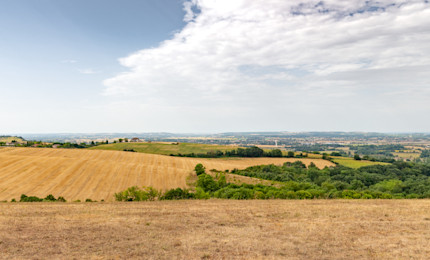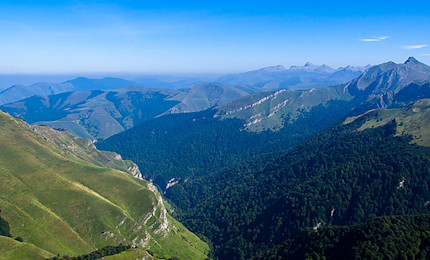Urgence gaz 0 800 028 800

Work on the gas transport grid: technical and territorial considerations
Quite apart from purely “technical” considerations, projects have to fit into the territories and their environment, with as positive an impact as possible. Projects such as the Capens Pamiers Renewal (RCP) gas grid maintenance project, opened at the end of November 2021.
Work on the gas transport grid, and the general interest question
When work on the gas transport grid is being planned, the starting point is not simply technical. For Teréga, there is also – and perhaps most importantly – the whole question of the general interests of the territory in question. “These days, a project pursues the objectives of territorial multi-energy mutualisation”, explains Thomas Roche, manager of the Capens Pamiers Renewal project at Teréga. “This means there are other considerations at work alongside the primary objective of modernising and securing our natural gas grid: facilitating connections to biomethane production and for new industrial customers emerging across the territory.” That is an essential step in supporting the energy transition and creating greater dynamism in the local community.
Expertise and well-established project steps
Completing a successful project on a transport grid involves all of these things:
technical knowledge: surveys, civil engineering, earth-moving, equipment, welding, lifting, drilling, pipework assembly, cathodic protection, electricity, automated systems, instrumentation etc.
environmental knowledge: study of fauna and flora, Avoid - Reduce - Compensate process, impact study, introduction of environmental protection measures,
administrative knowledge to support the process of submitting applications to institutional stakeholders,
interdisciplinary knowledge to orchestrate, manage and coordinate each step.
In fact, a Teréga work project goes through a series of 16 consecutive progressive steps. They run from a study of the route, which must give due consideration to the environment and to neighbours, to rehabilitation of the site after the work, not forgetting all the phases of making safe, installing and inspecting the new infrastructures, all involving different actors (external technical service providers, approved organisations, DREAL (Regional Directorate for Environment, Development and Housing) etc.).
Capens Pamiers Renewal (RCP), a major grid project
“RCP is a large-scale project which follows our infrastructure construction methodology very rigorously. It’s also a very specific project, with a great many interfaces with our customers (GDRF, industry) and stakeholders”, says Thomas Roche, project manager. This grid, in operation since 1947, was designated for complete reconstruction in 2016. The plan was to adapt this natural gas grid, choosing a route that was more favourable to the territories, but still maintaining the connection of 5 public distribution and 2 industrial distribution stations.
How could such a project be implemented, while maintaining our gas supply service? “The availability of our infrastructures is basically an essential requirement, to guarantee a permanent gas supply for our customers,” explains Thomas Roche. That’s why commissioning of the new installations had to follow a precise schedule, so that the gas supply to the GRDF and industrial networks was not interrupted.”
To bring this project to a successful conclusion, a large team was established, steered by Thomas Roche. In the project delivery phase, the Teréga steering team could reach as many as 15 people, including external supervision service providers. Overall, more than 230 people from participating companies were mobilised at the peak project delivery phase. That organisation enabled an efficient response to the different problems arising from the project.
Grid projects in tune with the Avoid-Reduce-Compensate philosophy
Teréga needed to work on a section passing beneath the Garonne, Ariège and two of their tributaries. “To manage our environmental impact, we applied the AVOID-REDUCE-COMPENSATE methodology throughout the whole duration of the project,” explains Thomas Roche. “So we chose the directional boring technique to limit impacts on the flora and fauna found on the banks of those watercourses.”
Communication with stakeholders: a major challenge in projects
“In addition to protecting biodiversity, we must also be careful to reduce our impact on human activities, the vast majority of which are agricultural, as much as we can. This is a constant concern, especially as we’re working on this project across two departments, with 150 landowners and operators affected,” adds Thomas Roche. The large section in the Ariège plain, for example, crosses farmland for nearly 38 km. So the impact on these large areas with high added value must be limited as much as possible. An agreement between the Haute-Garonne and Ariège Chambers of Agriculture and Teréga formed the basis for amicable negotiations as part of the RCP project. The organisation of territorial meetings also allowed the project, the associated works and the applicable land management arrangements to be explained.
Moreover, part of the project – 2.6 km – took place in an urban setting, since the grid runs through the town of Pamiers from East to West. It therefore required particularly careful communication with all stakeholders: communication with neighbours and cooperation with the Pamiers town council etc.

Beyond the technical: a positive impact for the territory
The RCP project clearly shows our commitment to the territories, but that commitment goes far beyond the technical. In fact, we are careful to share our objectives so that our projects generate positive spin-offs for local communities. “This is a process and a desire in Teréga that’s gaining in maturity. The aim is to add services on a regional and departmental scale,” explains Thomas Roche. Where the Capens Pamiers Renewal is concerned, those external spin-offs are of several different kinds:
Increasing the supply capacity of the new infrastructure could facilitate new prospects in the territory accessing the grid.
In the commune of Montaut (Ariège), a new agricultural methanisation unit (Arseme) is now connected indirectly to the new infrastructure, allowing it to operate at full capacity and inject biomethane into the grid.
The Departmental Council has entered into a transfer agreement with Teréga covering one 10 km section of the old structure, so that it can be re-used as a fibre optic cable conduit between Saint-Quirc and Saverdun.








